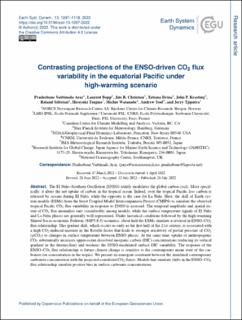| dc.contributor.author | Ayar, Pradeebane Vaittinada | |
| dc.contributor.author | al., et | |
| dc.date.accessioned | 2022-08-16T11:44:56Z | |
| dc.date.available | 2022-08-16T11:44:56Z | |
| dc.date.created | 2022-07-29T11:43:24Z | |
| dc.date.issued | 2022 | |
| dc.identifier.issn | 2190-4979 | |
| dc.identifier.uri | https://hdl.handle.net/11250/3012098 | |
| dc.description.abstract | The El Niño–Southern Oscillation (ENSO) widely modulates the global carbon cycle. More specifically, it alters the net uptake of carbon in the tropical ocean. Indeed, over the tropical Pacific less carbon is released by oceans during El Niño, while the opposite is the case for La Niña. Here, the skill of Earth system models (ESMs) from the latest Coupled Model Intercomparison Project (CMIP6) to simulate the observed tropical Pacific CO2 flux variability in response to ENSO is assessed. The temporal amplitude and spatial extent of CO2 flux anomalies vary considerably among models, while the surface temperature signals of El Niño and La Niña phases are generally well represented. Under historical conditions followed by the high-warming Shared Socio-economic Pathway (SSP5-8.5) scenarios, about half the ESMs simulate a reversal in ENSO–CO2 flux relationship. This gradual shift, which occurs as early as the first half of the 21st century, is associated with a high CO2-induced increase in the Revelle factor that leads to stronger sensitivity of partial pressure of CO2 (pCO2) to changes in surface temperature between ENSO phases. At the same time, uptake of anthropogenic CO2 substantially increases upper-ocean dissolved inorganic carbon (DIC) concentrations (reducing its vertical gradient in the thermocline) and weakens the ENSO-modulated surface DIC variability. The response of the ENSO–CO2 flux relationship to future climate change is sensitive to the contemporary mean state of the carbonate ion concentration in the tropics. We present an emergent constraint between the simulated contemporary carbonate concentration with the projected cumulated CO2 fluxes. Models that simulate shifts in the ENSO–CO2 flux relationship simulate positive bias in surface carbonate concentrations. | en_US |
| dc.language.iso | eng | en_US |
| dc.rights | Navngivelse 4.0 Internasjonal | * |
| dc.rights.uri | http://creativecommons.org/licenses/by/4.0/deed.no | * |
| dc.title | Contrasting projections of the ENSO-driven CO2 flux variability in the equatorial Pacific under high-warming scenario | en_US |
| dc.title.alternative | Contrasting projections of the ENSO-driven CO2 flux variability in the equatorial Pacific under high-warming scenario | en_US |
| dc.type | Journal article | en_US |
| dc.type | Peer reviewed | en_US |
| dc.rights.holder | © Author(s) 2022 | en_US |
| dc.description.version | publishedVersion | en_US |
| cristin.ispublished | true | |
| cristin.fulltext | original | |
| cristin.qualitycode | 1 | |
| dc.identifier.doi | 10.5194/esd-13-1097-2022 | |
| dc.identifier.cristin | 2040049 | |
| dc.source.journal | Earth System Dynamics | en_US |

